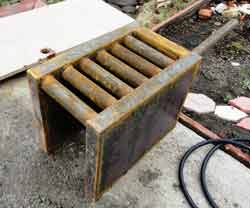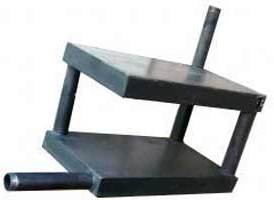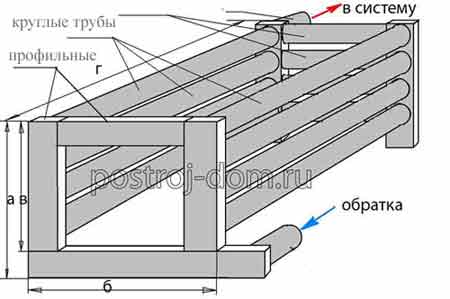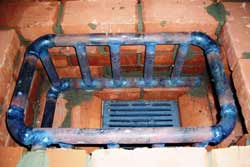There are a lot of options for heating your own private house. Usually. common brick ovens- the heat from the firebox and the crackle of firewood make the atmosphere cozy and unique. However, heated bricks cannot fully make a dwelling warm in each of its sections.
For this, the unit is being modernized, and laying a furnace with water heating is already quite common. How to do the work yourself and avoid errors that reduce the efficiency of the Russian stove is described below.
Scheme and principle of operation of a furnace with water heating
Before starting work, the wizard will need a natural representation of the entire assembly. To do this, a diagram is drawn up with the actual parameters of the furnace and boiler, the heating system can be the simplest - series-connected radiators, closed by a circuit of pipes on the boiler.
It is important to calculate the heat loss of the house so that the size of the boiler fully covers the energy costs. The actual dimensions of the furnace depend on what the boiler will be. If it is difficult for the owner to independently make calculations and drawings, then there is always the opportunity to order a project from professionals, where every moment is covered in detail.
The boiler is a cast-iron tank with two holes - they serve as a return flow. A tie-in for an expansion boiler must be made on the supply line, if necessary, water is added there, since the carrier tends to evaporate. Connected to the system circulation pump, allowing you to quickly warm up the premises, thereby using the efficiency in full.
Self-laying stoves with a water heating boiler is also quite possible. Lead the process from the foundation, then to the prepared combustion chamber install the welded unit and complete the masonry, prudently leaving outlets for connecting the boiler to the heating system.
How to independently fold the stove with a water boiler
The work is divided into several stages:
- Manufacture of a cast-iron boiler.
- Furnace lining.
- Joining the system.
The materials that will be needed for the process are described for each stage. So:
cast iron boiler
Why is this type of metal required? It is resistant to high constant temperatures.
However, one should be attentive to the fact that cast iron is fragile and temperature changes - pouring a cold carrier or abrupt ignition after a long break can not have the best effect on the condition of the boiler. For the design, ordinary heating radiators are suitable. They are dealt with as follows:
- Break down into component parts.
- Get rid of pads.
- The sections are washed with a solution of hydrochloric acid - it will help get rid of scale and other compounds that can affect the normal operation of the boiler.
- Then the sections are assembled using asbestos cord soaked in drying oil or paint. The cord is wrung out and tightly wound around the connections, carefully knocking the sections together.
- The supply and return are mounted diagonally, the remaining two holes are welded.
Boiler masonry
In the old days, the stove was folded before the house. The resulting structure was surrounded by walls, and thus, each light room received its portion of heat. Since our stove will provide heat to all rooms thanks to the system, it makes no sense to make the stove in the center of the house - every meter of usable area counts. So:
The finished pipe is covered from above with a decorative cap or visor - protection from natural moisture. Water can affect the quality of the furnace. Thus, the furnace is laid with a water heating boiler, the scheme of which is the simplest.
Connecting the furnace with the boiler to the heating system
Before you have to fix the supply and return of the furnace to the water pipes, you should choose the right components in advance. You need to know an important rule - the oven emits great amount heat, so the components of the system must withstand a water temperature of at least 80-85⁰. Further:
Thus, the resulting scheme of a furnace with water heating is embodied in the form of a brick unit with a boiler. You can start drying.
Drying the finished oven
It is impossible to proceed directly to ignition immediately. This threatens with irreversible defects, distortions and leakage of the boiler. Proceed as follows:
For subsequent operation, the owner needs to remember that garbage is burned in the furnace only when the combustion process is in intensive mode. Otherwise, a strong draft will pick up the scrap and, without allowing it to burn out, will carry it into the gas ducts, thereby reducing the efficiency of heat transfer. It is impossible to burn foil materials in the furnace - they are difficult to process, stick to the sections, thereby creating pockets of high temperatures - this leads to overheating and deformation of the boiler.
If the laying of the furnace was carried out from not too presentable material, then after checking all the working qualities of the unit, it is lined with clinker tiles, tiles, decorative bricks that can withstand high temperatures - there are a lot of offers from manufacturers.
Home furnaces with water heating, the scheme of which has been verified in advance, will serve their owners faithfully for many years, paying back the costs of their own design in the first year of operation. It is only important to regularly expose the system to preventive maintenance - to change fallen bricks, thoroughly clean the gas ducts and the common chimney, check the boiler surface for defects in the form of cracks. Usually, repair work is postponed to the summer period in order to enjoy the warmth and crackle of birch logs inside in winter.
You need to enable JavaScript or update the player!
In order for the stove to be used as a heat source for the water heating system of the house, a heat exchanger must be installed in it, in which the liquid heat carrier circulates, most often water. It is also called a furnace boiler or register. In this article, we will look at how to make such a heat exchanger for a furnace with our own hands and what it can be, depending on the type of furnace itself and the material used to make it.
In order to make a heat exchanger for the furnace with your own hands, you can use sheet "black" steel 3-5 mm thick or steel pipes(round or profile) with the same wall thickness and a diameter of 30-50 mm. Alternatively, stainless steel or copper sheet or pipes may be used for this purpose. But, due to their high cost, these materials are rarely used in the independent manufacture of furnace boilers.
It is easier to make such registers from sheet metal. They are easier to clean during use. But, as a rule, they have a smaller area of contact with the flame or hot gases, since for the most part they are continuous and only their inner surface, facing the flame, participates in heat exchange.
Furnace boilers made of pipes, with the same overall dimensions, as a rule, have a large heat exchange area (although this also depends on the number and diameter of the pipes), since they allow flames or hot gases to contact almost their entire surface. But they are more difficult to manufacture. This is especially true for structures consisting entirely of pipes of circular cross section.
If for the manufacture of a heat exchanger for furnace with water circuit pipes are used, it is best if they are seamless (solid-drawn). If seam pipes are used, then the seams will have to be additionally strengthened with a welded seam and located on the outside of the register (on the side of the brickwork).
Very often, in the manufacture of furnace boilers, pipes and sheet iron are combined. This is done in order to use their positive qualities: to make it easier to manufacture, and the heat exchange area is sufficient.
What types can be homemade furnace heat exchangers
In addition to the structural differences of furnace boilers discussed above, depending on the material chosen for their manufacture, their designs may also differ depending on oven type for which they are actually intended. Such furnaces can be heating or heating and cooking.
The design of the heat exchanger for the heating and cooking furnace is different in that in its upper part there is an open space for flame access to hob. In registers for heating stoves, the upper part, as a rule, is closed with a solid sheet or rows of pipes.
The shape and dimensions of furnace boilers are selected in accordance with the size and shape of the place where they are supposed to be installed (most often it is the furnace firebox), and also depending on its required heat output.
Boiler designs for heating furnaces with a water circuit
Here we will look at the three most common designs, made separately from sheet metal and pipes, as well as their combinations.
Option 1.
The heat exchanger is a solid U-shaped structure, welded from sheet metal, designed to be located in the firebox heating furnace. The heat exchange surface is its inner walls.
Sheet metal heat exchanger for heating furnace
Option 2.
Furnace boiler from pipes. Cold water from the system is supplied through the "return" into the lower U-shaped pipe of the heat exchanger base (40-50 mm in diameter and 3-4 mm wall thickness), gradually heating up, it is through L-shaped vertical pipes (of the same cross section as U-shaped base or less) rises and enters the upper collector pipe, and from it, already heated, into the heating system of the house. Such a register is more efficient than one made of sheet steel, but also more difficult to manufacture, since many pipe joints will have to be made and welded together.

Furnace register for a heating furnace made of pipes
Option 3.
The side surfaces of this register are made of sheet metal with a thickness of 3-5 mm and are solid panels with a thickness of 40-45 mm, and the upper part they are interconnected by a row of horizontal pipes with a diameter of 40-50 mm.
The use of pipes instead of a solid surface (as in option 1) allows you to increase the area of contact with the heating medium, and the use of sheet metal for the side panels simplifies the manufacturing process, which is important if you decide to do it yourself.

Furnace boiler made of sheet metal and pipes for a heating furnace
Furnace boilers (registers) for heating and cooking furnaces
Heat exchangers for heating and cooking stoves can also be made from both sheet iron and pipes (round or profile), as well as by combining them. Let's consider several options.
Option 1.
Heat exchanger for heating and cooking stove or cooker in the form of two solid side panels made of sheet metal ("book"), interconnected.

Heat exchanger for heating and cooking stove
Option 2.
A furnace boiler made of pipes of round and rectangular cross-section: round pipes (40-50x4 mm in diameter) are located horizontally and are connected into a structure using rectangular pipes 50-60x40x4 mm. Such a combination different types pipes facilitates the manufacture of the boiler. Dimensions a B C And G calculated, depending on the size of the firebox and required power register.

Heat exchanger for a heating and cooking furnace made of round and shaped pipes
Option 3.
Heat exchange register only from round tubes. It consists of two horizontal circuits connected by vertical pipes. Cold water from the system is supplied to the lower circuit, and heated from the upper circuit is fed back to the heating system.

Register for a heating and cooking furnace made of pipes
How to choose or calculate the dimensions of the furnace boiler
After you have chosen the type of heat exchanger, you need to determine its dimensions. On the one hand, its dimensions must correspond to the size of the place where it will be installed.
Most often, heat exchangers are placed in the furnace firebox, but sometimes in smoke channels or chamber of a channelless furnace. At the same time, it must be taken into account that between brickwork and the register should be a gap of 0.5-1 cm, taking into account the thermal expansion of the metal.
In addition, it is necessary to know the required power of the furnace heat exchanger. How to define it?
It depends on the thermal power of the water heating system required to heat the house, which in turn depends on the thermal insulation properties of its external structures and the maximum negative outdoor temperature in winter. Simplified, you can focus on the average: 10-12 kW per 100 m 2 of the area of \u200b\u200bthe house.
How to calculate the required area of the furnace boiler to provide such heat output? On average, it is generally accepted that to provide a thermal power of 5-10 kW, about 1 m 2 of the heat exchange surface of the boiler is needed. The value of this indicator depends on the temperature of the hot gases in contact with the heat exchanger and the temperatures of the water (coolant) at its outlet and inlet, which in turn largely depends on the mode of the furnace and the type of fuel.
The total power of the heat exchanger can be calculated by the formula:
Q=SQsp,
where: Qud is its specific power, kcal/hour;
S- its useful area (contact with the heating medium), m 2.
Specific power can be calculated using the formula:
Qsp = k(T-t)S,
where: k\u003d 12 kcal / hour per 1 ° С - heat transfer coefficient "gas-water" through the steel surface;
T= (Tmax+Tmin)/2 – average temperature of the heating medium (flame, gases), °С;
t= (tmax + tmin) / 2 - the average temperature of the coolant (inlet + outlet / 2), ° С.
If the stove will operate periodically (about 2 hours) on wood, then the average temperatures of the environment and the heat carrier will be maximum: 500 and 70 ° C, respectively, and in this case it will be possible to obtain a maximum of 6 kW of thermal power from 1 m 2 of the heat exchanger.
If the furnace will work on coal and constantly, then the average maximum average values of the medium and coolant can be: 800 and 70 ° C, respectively. In this case, about 10 kW can be removed from 1 m 2 of the area of \u200b\u200bthe furnace boiler.
If the total required thermal power of the boiler and the mode of combustion (and hence its specific power) are known, then it is quite possible to determine which usable surface area he must have:
S \u003d Q / Qsp, m 2.
Depending on what material the heat exchanger will be made of, it is possible to calculate how many pipes or sheet metal are required to provide such an area of contact with the heating medium. In this case, only the surface that will be in direct contact with hot gases or flames is taken into account.
For example, if the furnace boiler will be made solid (only from sheet metal), then only its inner surface should be taken into account. If it is made of pipes, then almost their entire surface will participate in heat transfer (their length x diameter x 3.14). When combined different materials, it will be necessary to calculate the area of contact with the heating medium of each element separately, and then summarize.
If you need to increase thermal power boiler with the same overall dimensions, it is possible to add additional elements to its design (for example, pipes). If its power turns out to be too large, then its length can be reduced. In other words: in each specific case, it is necessary to calculate and adjust the size of the register, linking them to the size and design of the furnace itself, as well as the power of the house's water heating system, which will have to be provided with thermal energy.
DIY manufacturing
After the type of furnace boiler is selected, the material and the size calculation is made, you can start making it yourself. At the same time, it is necessary to pay attention to the quality of welding work. It should be at a high level, since this unit will be operated in a rather aggressive environment, and in order to repair it, most likely, you will have to disassemble the furnace or part of it. Therefore, if you are not confident in your abilities as a welder, then it is better to entrust this work to an experienced specialist, having previously prepared all the necessary structural elements.
After welding, it is necessary to fill the register with water, check for leaks and pressure test it at a pressure that is at least 2 times higher than the working pressure in the heating system.
Do-it-yourself heat exchanger for the oven video: